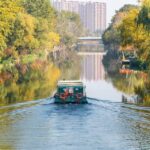A rare opening at the Wagah Attari border
For the first time since deadly clashes in May, Sikh pilgrims from India crossed into Pakistan by land to mark the 556th birth anniversary of Guru Nanak, the founder of Sikhism. Pakistan issued more than 2,100 visas, and authorities said about 2,000 pilgrims entered the country on November 4. At the Wagah Attari crossing near Lahore, officials greeted the arrivals with flowers while border guards guided orderly lines on both sides.
The crossing is the largest civilian movement at the frontier since the four day exchange in May, the worst fighting between the neighbors since 1999, left more than 70 people dead and froze regular travel. The land border had been closed to general traffic, and the Kartarpur Corridor, a separate route that lets Indian Sikhs visit a major shrine without passing through the main checkpoint, also remained closed. Many pilgrims walked across carrying luggage and gifts, some with family members making the journey for the first time.
The visitors will spend ten days at shrines across Pakistan. The centerpiece is Nankana Sahib, Guru Nanak’s birthplace in Punjab, with ceremonies at Gurdwara Janam Asthan. Pilgrims will also pray at sites in Lahore and at Kartarpur, where Sikh tradition holds that the guru spent his final years. For many, the trip blends devotion with a return to ancestral towns split by the 1947 partition that created India and Pakistan. Pakistan’s High Commission in New Delhi said the visa decision supported religious freedom and cultural understanding.
Who is traveling and why it matters
Guru Nanak Gurpurab is one of the most important dates in the Sikh calendar. Communities across India, Pakistan, and the global diaspora gather for hymn recitation, processions, and communal kitchens known as langar. For Sikhs in India, access to shrines in present day Pakistan carries special weight because several of the most revered places in the faith lie west of the border.
The 1974 bilateral protocol on visits to religious shrines provides a framework for such travel. Under that arrangement, groups receive visas for set festivals. Pakistan’s Evacuee Trust Property Board and the Ministry of Religious Affairs coordinate logistics on the Pakistan side, while Sikh bodies in India help assemble delegations. This week, travel is organized around a calendar that includes prayers, site visits, and cultural events over ten days.
Where pilgrims will pray
- Gurdwara Janam Asthan in Nankana Sahib
- Gurdwara Dera Sahib in Lahore
- Gurdwara Panja Sahib in Hasan Abdal
- Gurdwara Darbar Sahib in Kartarpur
These sites mark key chapters in the life of Guru Nanak and the early growth of Sikhism, and their proximity across the border keeps cross border pilgrimage central to the faith’s lived practice.
What happened in May and why the border closed
Tensions spiked after an attack in the Indian administered Kashmir town of Pahalgam on April 22 killed 26 tourists. New Delhi accused Islamabad of backing the assailants. Pakistan denied the allegation and called for an investigation. In early May, the two sides traded artillery fire, drone strikes, and limited missile attacks over four days. More than 70 people were reported killed, making it the most dangerous flare up since the Kargil conflict of 1999.
U.S. President Donald Trump later said he had brokered a ceasefire to halt escalation. The Wagah Attari crossing was then shut to travelers for months, and the Kartarpur Corridor stopped operating. Embassies scaled back services, and dialogue in other areas stalled. Tuesday’s movement of Sikh visitors took place as a special exception tied to a religious calendar.
Why the Wagah Attari crossing matters
The Wagah Attari gate linking Lahore and Amritsar is the only active land crossing for travelers between the two countries. It is a tightly controlled zone that usually handles diplomats, medical cases, limited goods, and officially sanctioned groups. When movement pauses, families who live on opposite sides lose one of the few channels left for direct contact.
Kartarpur Corridor and its pause
The Kartarpur Corridor opened in November 2019 as a dedicated route from Dera Baba Nanak in India to Gurdwara Darbar Sahib in Kartarpur, Pakistan. Indian citizens can apply online for a permit and travel to the shrine for the day without a Pakistani visa. The walkway is short, crossing farmland along a fenced track straight to the complex, and the visit ends at sunset.
The corridor quickly became a symbol of religious access in a hard border region. It allowed elderly devotees to visit a site only a few kilometers away that had been out of reach for decades. Since the May fighting, the route has been shut. That closure has pushed more demand onto the limited event based visas arranged for group pilgrimages.
On the ground at Wagah
Pilgrims queued early on the Indian side under watch from the Border Security Force, many in saffron and navy turbans, some carrying their luggage on their heads. On the Pakistan side, officials from Punjab’s minority affairs department and the Evacuee Trust Property Board welcomed the visitors with flower garlands and rose petals.
Nasir Mushtaq, a senior official at Pakistan’s Ministry of Religious Affairs, said the decision to reopen the crossing for the festival showed respect for religious minorities and a desire to keep cultural connections alive despite political disputes.
Pakistan’s High Commission in New Delhi described the visa decision in moral and cultural terms.
The decision to grant visas was consistent with efforts to promote interreligious and intercultural harmony and understanding.
One Sikh pilgrim, speaking to reporters at the border after crossing into Pakistan, captured the mix of relief and hope felt by many travelers.
It does not feel like we are in another country. I hope visitors from Pakistan receive the same welcome in India.
Religious diplomacy under a 1974 protocol
The 1974 India Pakistan Protocol on Visits to Religious Shrines outlines an annual schedule of group travel for Hindus, Muslims, and Sikhs. The document was designed to help communities reach sites sacred to them that ended up across the border in 1947. Pilgrims do not travel as ordinary tourists. They are registered in groups, issued specific visas, escorted by host officials, and hosted at gurdwaras or rest houses.
On the Pakistan side, the Evacuee Trust Property Board manages Sikh and Hindu sites. It arranges lodging, security, and transport to and from shrines such as Nankana Sahib, Panja Sahib, and Katas Raj. On the India side, Sikh institutions such as the Shiromani Gurdwara Parbandhak Committee often coordinate rosters and support for those making the journey. The protocol has survived long periods of political frost because it focuses on religious access rather than politics.
This week’s crossing fits that pattern. It is a narrow opening for a defined purpose, leaving most border restrictions in place. Organizers and security agencies on both sides had weeks to plan routes, crowd control, and housing to keep the focus on worship.
What this means for India Pakistan ties
The movement of Sikh pilgrims signals a limited easing around a religious festival, not a broad reopening. Trade remains restricted, high level talks are quiet, and the Kartarpur Corridor is still paused. Even so, visible cooperation at a sensitive checkpoint creates a window where local officials talk, practical problems are solved together, and mistrust can soften at the edges.
Analysts who track South Asia often look at small steps that keep contact alive during long diplomatic freezes. Events anchored in faith and culture fall into that category. If the current festival passes without incident, officials could weigh whether to resume the corridor at Kartarpur, expand future pilgrimage rosters, or revive stalled small scale travel for medical patients and divided families.
For now, the focus is on those who made it across for Guru Nanak Gurpurab. Many will go home with fresh memories of shrines they had only seen in photographs and stories. The sights and interactions at Wagah may not change policy overnight, but they renew the human ties that often outlast political cycles.
Key Points
- First major crossing since May fighting, about 2,000 Indian Sikh pilgrims entered Pakistan on November 4.
- Pakistan issued more than 2,100 visas under the 1974 Protocol on Visits to Religious Shrines.
- Pilgrims are attending a ten day festival marking the 556th birth anniversary of Guru Nanak.
- Major sites on the itinerary include Nankana Sahib, Dera Sahib in Lahore, Panja Sahib, and Kartarpur.
- Wagah Attari reopened for pilgrims while general travel remains shut.
- The Kartarpur Corridor has stayed closed since the May conflict.
- The May flare up followed an April 22 attack in Pahalgam that killed 26 tourists, with more than 70 people later reported dead in four days of exchanges.
- Pakistan’s High Commission presented the visas as a step to support interreligious and intercultural harmony.
- A senior Pakistani official said reopening for the festival shows respect for religious minorities and cultural links.
- Many pilgrims voiced hope for friendlier cross border visits.




